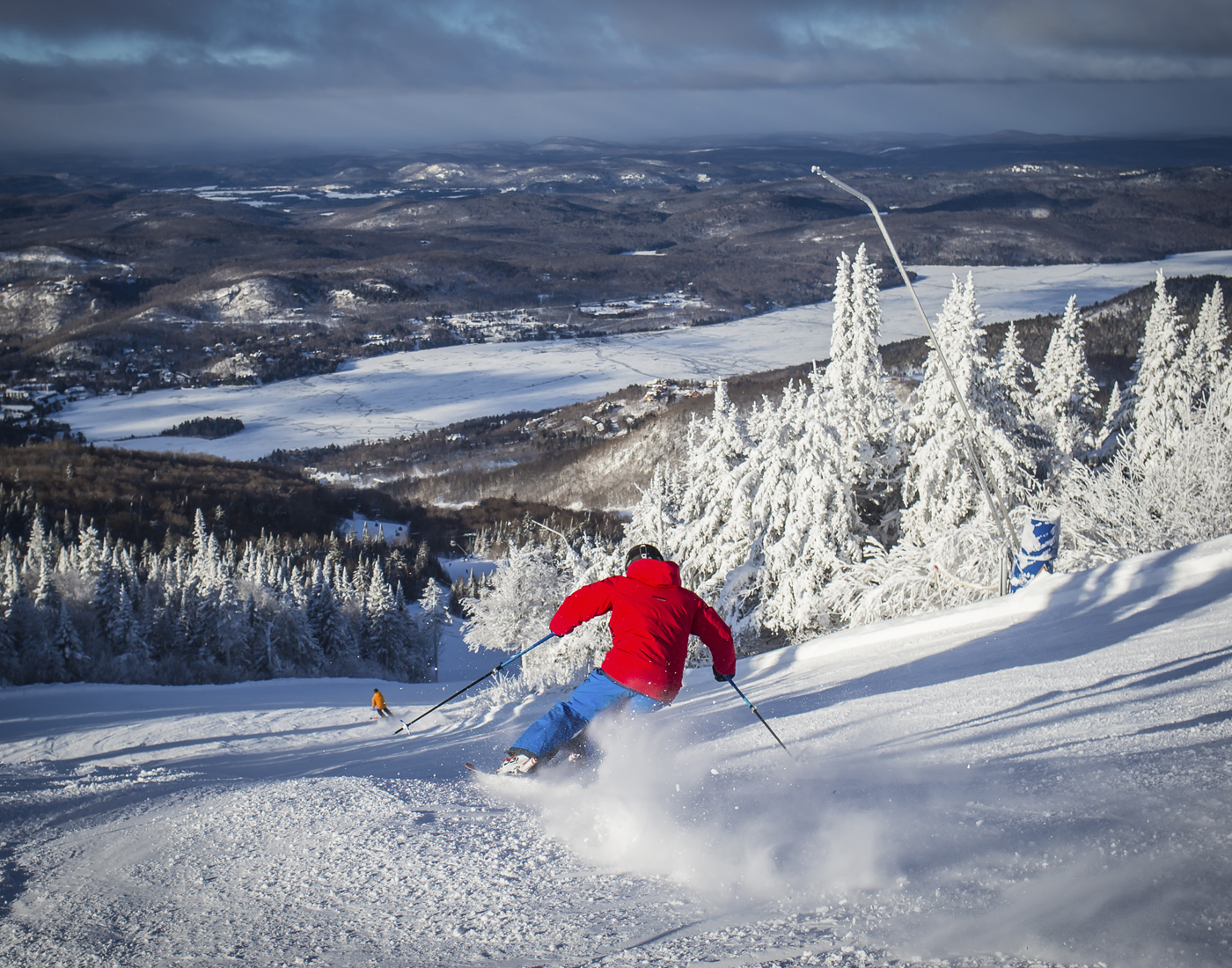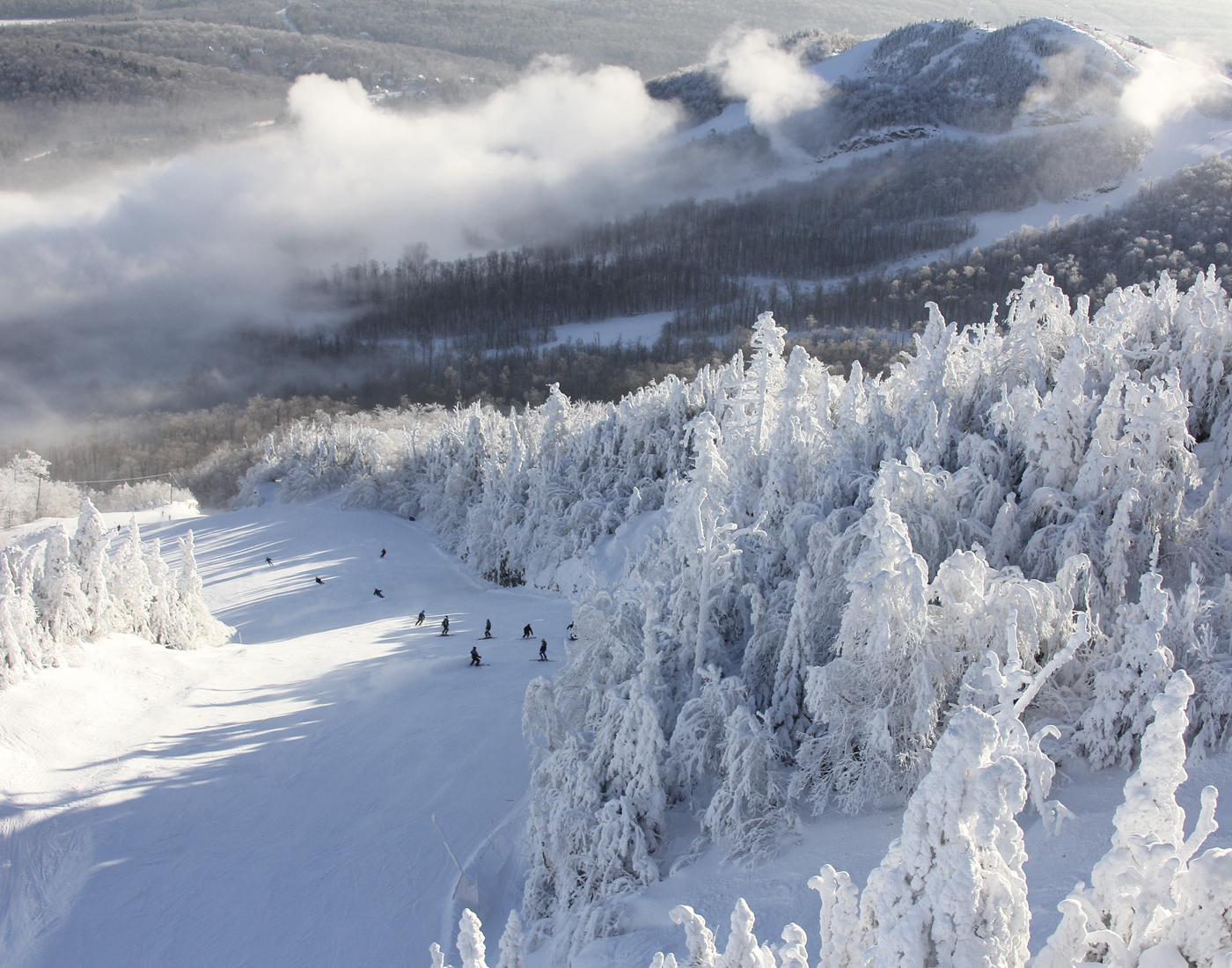The Many Charms of Québec
For Eastern skiers, colorful and charming French Canada is the perfect getaway: both exotic and easy to access. Here’s our guide to each skiable region.
WORDS • JOE CUTTS |FEATURED IMAGE • ANDRÉ-OLIVIER LYRA
Québec City and Charlevoix
If having three major ski areas within an hour’s drive makes Québec City a ski town, then it certainly must be the single coolest ski town in the world. And if you’re one of those kooks who really, really loves winter, they speak your language here, even if it sounds like French.
As great as the skiing is at the three resorts—Mont-Sainte-Anne, Stoneham, and Le Massif de Charlevoix—the city will leave the most indelible imprint of your post-visit memories. Québec, an ancient walled city perched on cliffs above the water at the point where the St. Lawrence River narrows and turns from salt to fresh, is so rare, historic and beautiful it deserves its UNESCO World Heritage designation for outstanding cultural heritage.
Old Québec is a delightful maze of narrow cobbled streets and alleys, sloping and winding between historic stone buildings crammed with shops and restaurants and just enough touristy kitsch. The original Lower Village (Basse-Ville), lines the waterfront where explorer Samuel de Champlain came ashore in 1608. High above, atop a virtual cliff and connected by funicular, the castle-like Château Frontenac commands the river. (If you’re booking a hotel in town, choose either the Château itself, or one that has a good view of it.) At the edge of the cliff in front of the Château is Québec’s famous Terrasse Dufferin, a vast boardwalk. At one end is the famous Glissade, a thrilling toboggan chute that’s obviously so beloved by locals and visitors alike it makes you wonder why every ski town doesn’t have one.
In winter, the hardy, fun-loving Québecois go a little crazy, embracing winter in passionate and sometimes antic ways. Sledding, skating, ice-climbing, racing canoes across ice-flowed water, etc. And yes, partying their way through the dark and frigid months. It all comes to a head during February’s massive Québec Winter Carnival, a Mardi Gras for revelers who aren’t afraid of a little cold weather, billed as the world’s largest winter festival.
Just to reiterate, it does get cold up here. And wonderfully snowy, too. Which is why if you’re making your first turns of the season at nearby Mont-Sainte-Anne, about a half-hour’s drive from the city, you’re likely to be sharing the slopes with racers from the many New England ski clubs who come here annually for reliable early-season training. Mont-Sainte-Anne—2,050 vertical feet; 547 skiable acres—is the biggest of the local ski areas, famous for great views of the river from its 2,625-foot summit and for having the longest night skiing runs in Canada.
With runs on slopes that face three directions, Mont-Sainte-Anne’s layout lets skiers follow the sun all day long. The steep west side keeps experts busy with tough terrain, and that tends to keep them off the mellower runs at the eastern edge, where beginners can cruise in peace and safety. Mont-Sainte-Anne has been working hard to expand its gladed tree-skiing options in recent years. And if you’d rather sleep slopeside than in the city, all three ski areas offer plenty of options, from hotel room to private chalet, at the base area.
Stoneham, too, has kept up with the times by improving its gladed offerings and also has lots of lighted trails for night skiing. But the real specialty here is the freestyle scene. Stoneham—1,132 vertical; 331 acres—is famous for its expansive terrain park offerings, including the province’s only halfpipe (“demi-lune”) and has hosted numerous international freestyle events (though last year’s FIS big air comp was held right in the city—how cool is that?). Stoneham’s are the closest slopes to the city (20 minutes). And even if you’re not there for the terrain parks, you’ll enjoy the horseshoe layout of its terrain: All trails descend to a single base area that is noticeably sheltered from the wind. Also nice on cold days: a high-speed “bubble” quad, La Tempête Express, for cozy rides up. And Stoneham further enhanced its uphill capacity with the recent addition of L’Éclipse quad.

Le Massif, about an hour’s drive east along the river into the beautiful, rural Charlevoix region, may be one of the world’s most interesting ski areas. Its summit, day lodge, and parking areas are accessible by the main highway, and its slopes descend from there a whopping 2,526 feet to the river’s edge. The place skis as big as any in the East, with lots of challenging glades, bump runs, and even a FIS-standard super G run. But nowhere this side of Norway do you spend a ski day in full view of so much salt water. The river is a good 10 miles wide here, and you’re likely to see ocean going freighters headed upstream (skier’s right) to the Great Lakes or downstream (skier’s left) to the Atlantic.
And now, there is a new baseside development at Le Massif de Charlevoix (owned by one of the founders of Cirque du Soleil, which got its start near here), including a new hotel and many chalets for rent. In addition, Canada’s first Club Med is already under construction at the foot of the slopes. It’ll be a showcase of the latest environment-friendly building techniques, and it’s expected to open, operating under the usual all-inclusive Club Med formula, by December of 2020.
Though the locals do speak English, this far north, their first language is French, which adds to the feeling that you are skiing in Europe. Meanwhile, wherever you ski in the Québec-Charlevoix region, the usual benefits apply. The Québecois take food seriously, so you can expect to eat very, very well. And depending on the exchange rate, you can expect to feel like you’re getting a nice discount on everything. Whatever you do, don’t forget your passport.
The Laurentians
There once was a ski area in Montréal, right up there on Mont-Royal, where the Red Bird Ski Club used to get after it. My vote would be to bring all that back, but in the meantime Montréal skiers only have to drive an hour or so north on 15 before they can step into their Rossignols. They don’t complain. For cooped-up city-dwellers, a wintertime trip to the Laurentians is a welcome treat.
American skiers, too, are discovering the charms of the Laurentians (or, in local parlance, Les Laurentides) in recent years. They come out of curiosity, for the food, for the Québecois culture—for something different. Many are drawn specifically to the region’s biggest and oldest resort, Mont Tremblant, to see what all the fuss is about.
Of all the Laurentians resorts—which are numerous, big and small—Tremblant, the cradle of the Canadian ski industry, is the farthest from Montréal (about 90 minutes). Its slopes, comprising a respectable 2,116 of vertical, spill off both sides of its 2,871-foot summit—cruisy stuff on the front side, rowdy bump runs on the backside, mellow trees on a sun-drenched side-hill.

But it’s the base village that leaves the most durable memories. Constructed from scratch over a decade or so, it’s an exemplar of resort planning. Tremblant visitors ditch their cars and happily spend their time on foot, strolling narrow streets and alleys lined with shops, bars and of course (this being Québec) exceptionally good restaurants and cafes. Brightly colored rooftops and thoughtfully cohesive architecture evokes the Québec vernacular—you could almost be in Vieux Port or Québec City neighborhood. A commuter lift from parking lot to the edge of the slopes soars above it all, welcoming day-trippers with a bird’s eye view of the village skyline and the slopes above. (A commuter ski trail that snakes through the village brings them back to the lot at day’s end.) Kids of a certain age can roam freely, if they’re not still splashing around in Aquaclub La Source indoor pools. Adults can enjoy the famous Tremblant après scene…or relax in superlative comfort in grand slopeside lodgings.
Meanwhile, over at nearby Mont Blanc, skiers—and especially families in search of a quiet, affordable getaway—enjoy a more laidback and soulful experience. Mont Blanc is known for especially good natural snow, thanks to north-facing aspect and its location well up on the Laurentian Highlands. (Only Tremblant, whose slopes are visible from Mont Blanc, has a higher summit.) Beginner and intermediate terrain abounds, but experts can find steeps and glades over on Mont Blanc Nord—as well as some of the best views in the Laurentians. Back at the base area, a heated pool and indoor play zone (Jungle Magique), keeps the kids happy while mom and dad enjoy their après beer by the fireplace at the bar.
Back down toward Montréal, families love Sommet Saint-Sauveur too, but there’s a whole different vibe, and a lot more action. Sommet Saint-Sauveur, first and foremost, is known for its night skiing, and the place pulses with activity after dark. Montréal is only 50 miles away, making it an ideal after-work getaway for a few runs and a beer. Some après visitors don’t even bother to ski; they’re just here for the party at the famous T-Bar 70.

But partying and skiing are far from the only attractions. The village of Saint-Sauveur itself bustles with activity and brims with things to check out: boutique stores, art galleries, cafes, restaurants—there’s even a little ski museum dedicated to the history and culture of skiing in the Laurentians.
But such diversity of activities is the norm throughout the Laurentians, where every kind of winter fun is on offer: dog sledding, snowmobiling, ziplines, mountain coasters, sugar shacks, as well as indoor play zones and water parks for the kids and luxurious spas for the adults. The Québecois take winter fun to another level, and they’ll infect you with their enthusiasm.
Be warned, they’re also likely to ruin your appetite for the food typically offered at American resorts. From the base lodge cafeteria to the candle-lit tables of the finest Laurentian restaurants, the food’s just better up here.
And what’s new? Plenty. Sommet Saint-Sauveur has big improvements slated for the coming season, including a base-lodge rebuild and a heated high-speed bubble-enclosed six-pack chairlift for those Canada-cold days and nights. And there’s new energy and investment at Tremblant, as well, since its acquisition by the Alterra Company (the group whose Ikon pass offers access to Aspen, Mammoth, and a host of other prestigious ski destinations). Under Alterra, Tremblant is in the midst of a $17-million (CAN) capital-improvements project that includes last year’s replacement of the Lowell Thomas lift with a high-speed quad as well as a renovation of the summit lodge. And in January, the C Hotels group announced plans for a new $45-million (CAN), 92-unit luxury hotel at the base of Tremblant’s Versant Soleil area.
So brush up on your French. Or don’t—this is a pretty bilingual part of Québec. But do bring your appetite and your love of winter. You’ll be in good company.
Eastern Townships
In some ways, skiing in Québec’s Eastern Townships feels familiar to a New England skier. Rolling mountains, winding roads, snow-covered lakes, quaint villages, working dairy farms, and even sugar shacks. (Québec, besides being way better at hockey, makes more maple syrup—sirop d’érable—than even my home state of Vermont.)
What’s more interesting, of course, are the dissimilarities. Almost everyone speaks French. The food, everywhere you go, is way better. Lift tickets are cheaper. And private and public investments in the region are spectacular—all in the name of buttressing an already vibrant tourist economy and ensuring healthy outdoor recreation opportunities for locals and visitors alike. (Government corduroy? Imagine that in Vermont.)
The past year or so has seen another generous round of investment. The Townships resorts—Bromont, Mont Orford, Owl’s Head, and Mont Sutton—all got their share, perhaps making it a better time than ever to venture north of the border for something a little more exotic than the same-old ski vacation.
Let’s start with Bromont, which, owing to its proximity to Montréal, is by far the most popular of the four Townships resorts. You might groan when you pull into its huge, car-packed parking lot. The slopes you can see from there don’t look big enough for all these skiers. But don’t despair; there’s far more terrain than meets the eye, spread out in successive terrain pods sprawling over 450 skiable acres. Fast and efficient lifts, including a sleek new chondola, take you from peak to peak, and on all but the busiest days it’s easy enough to find room to cruise.

Bromont is famous for its vibrant night skiing scene and affordable lift and pass offerings, which combine to attract a youthful crowd from Montréal, especially on its signature Nuits Blanches (White Nights), when the lifts spin till 2 a.m. Something I’ve never seen anywhere else: Even some of the gladed runs are lit for night skiing.
There’s a charming historic village nearby, and busy Bromont lacks nothing for vacation amenities, from slopeside chalets to spas, restaurants and lively bars.
About 28 miles east on Autoroute 10, the vibe at Mont Orford is totally different. Orford, located as it is at the edge of a protected national park, has no slopeside commercial clutter—a nice day lodge, a bar and restaurant, but that’s about it. (You won’t have far to go to find nice accommodations: The comfortable Espace Quatre Saisons is less than a mile away, just outside the park.) What Orford does have is the highest elevation (2,790 feet), longest vertical drop (1,933 feet), and, arguably, the most interesting terrain of all the Townships resorts. Skiers are whisked to its summit by a chondola just like Bromont’s (though Orford had it first), and from there they can enjoy beautiful views in all directions of the surrounding landscape.

As good as the views are from the top of Mont Orford, they are rivaled and probably surpassed by those of Owl’s Head, which is located a half-hour south of Orford, just a few miles from the Vermont border on the shores of Lake Memphremagog.
Owl’s Head, long regarded as the humblest of Townships resorts (though with bargain prices to match) is truly on the move these days. It’s got a fancier name now—Owl’s Head sur le Lac, homage to its perch on the shores of Lake Memphremagog. And with help from the province, its new owners—a group of wealthy Montrealers with fond ties to the area—are pouring in money and energy to affect a rebirth of the place. There’s already been a sleek, modern makeover of the lodge/hotel/restaurant complex, renamed the MTN House, which now offers a handful of luxurious suites upstairs as well as an all-new kitchen/bistro/bar overseen by a big-name chef hired away from a highly regarded Laurentians restaurant. That’s just a start: Plans call for a new 50-room hotel, plus additional slopeside and lakeside homes and condos.
Spend your day at Owl’s Head schussing is mostly mellow groomed runs, stopping occasionally to take in grand views of the lake, which stretches southward across the border far into Vermont. That’s Jay Peak in the near distance—so close as to almost be a fifth Townships resort. And across the water, to the east, you can see the spires of the famous Saint-Benoît-du-Lac Abbey. The monks there have been making artisanal cheese, including a face-melting bleu called Ermite, since way before artisanal cheese was a thing. It’s right there on the après menu down at the new base-lodge bistro. Or you can find your Ermite, along with all the many, many other delicious Québecois cheeses, at the fragrant little fromagerie in the village of Sutton.
Sutton is my personal gateway to the Townships, owing to its proximity to my Burlington home (and that cheese shop, Rumeur Affamee). It’s a tidy little village with a lively arts community at the southwest corner of the Townships region, less than 10 miles from the border.
Mont Sutton’s slopes lie at the top of a long, winding access road leading up from the village, and when you get there you might feel like you’ve stepped back in time—especially when you see their fleet of classic, orange-colored Tucker Sno-Cats. It’s a soulful, laidback resort that time forgot, and is famous for its tree skiing. Think Mad River Glen, except most people are speaking French.
The beautifully maintained Sno-Cats are a Sutton icon—like Mad River’s Single Chair—and they evoke the Townships’ rich heritage over-snow transportation innovation. (They gave us native son Joseph-Armand Bombardier, inventor of the Ski-Doo and pioneer of snow-grooming vehicles.)
If there can be such a thing as groomed tree skiing, Sutton’s got it, thanks to the compact maneuverability of the Sno-Cats, which groom narrow ribbons of trails through the hardwood forests between some of the main runs. There’s plenty of manmade corduroy to be found, but you come here for the natural stuff. Many Sutton skiers are happiest when they’re deep in the trees, seeking untracked adventure—Sutton averages 200 inches of it a year.
At day’s end, they can linger with friends and fellow winter-lovers in Mont Sutton’s warm and inviting slopeside bar (called Le Tucker, of course), then head back down to the bustling little village in search of—what else?—more of that famous Québecois cuisine.
The busy U.S. holidays, when American slopes are mobbed, are a particularly good time to head north of the border. But whenever you go, don’t miss the cheese.

